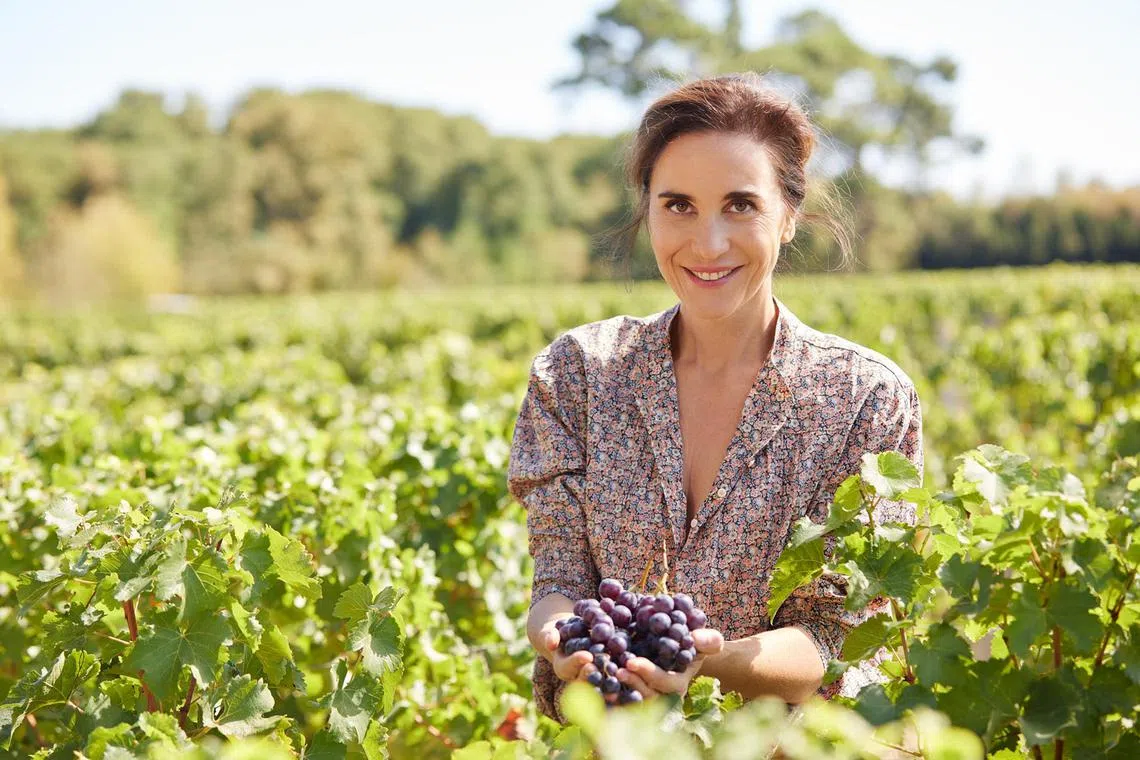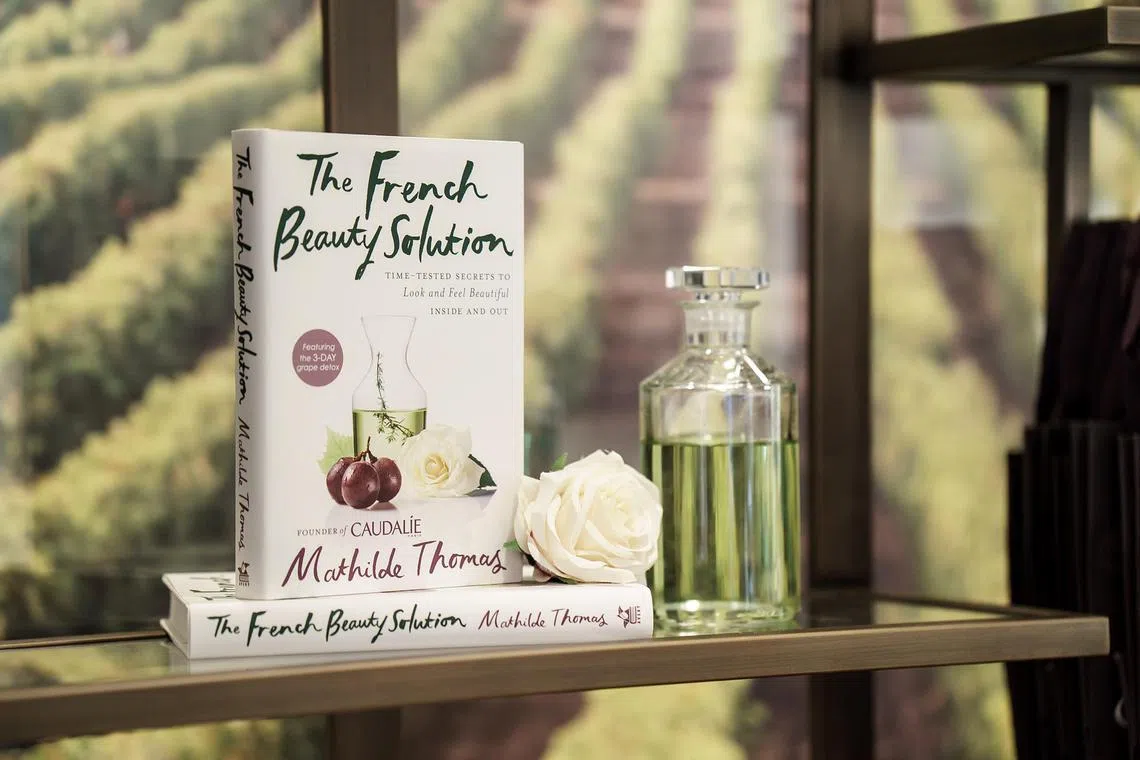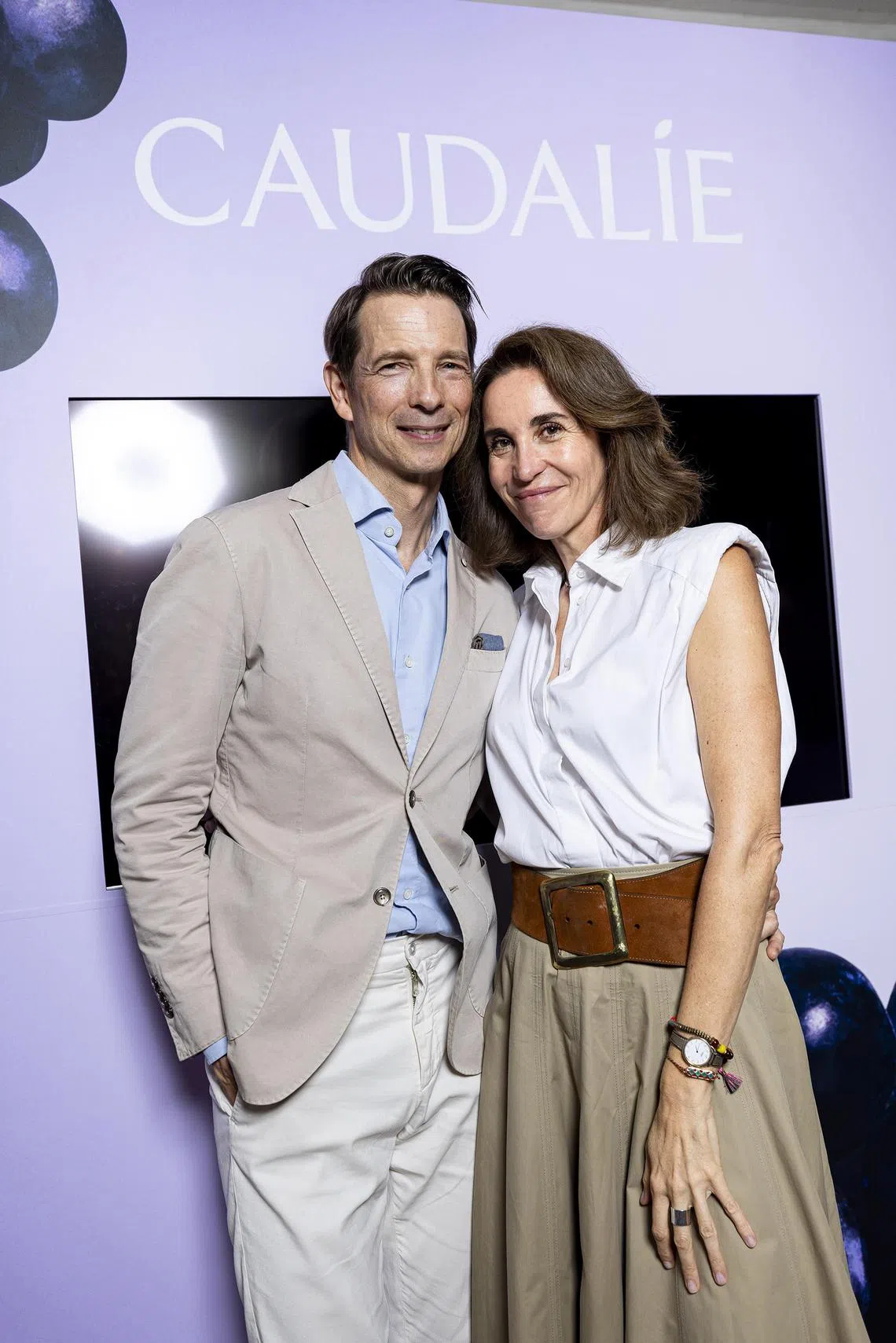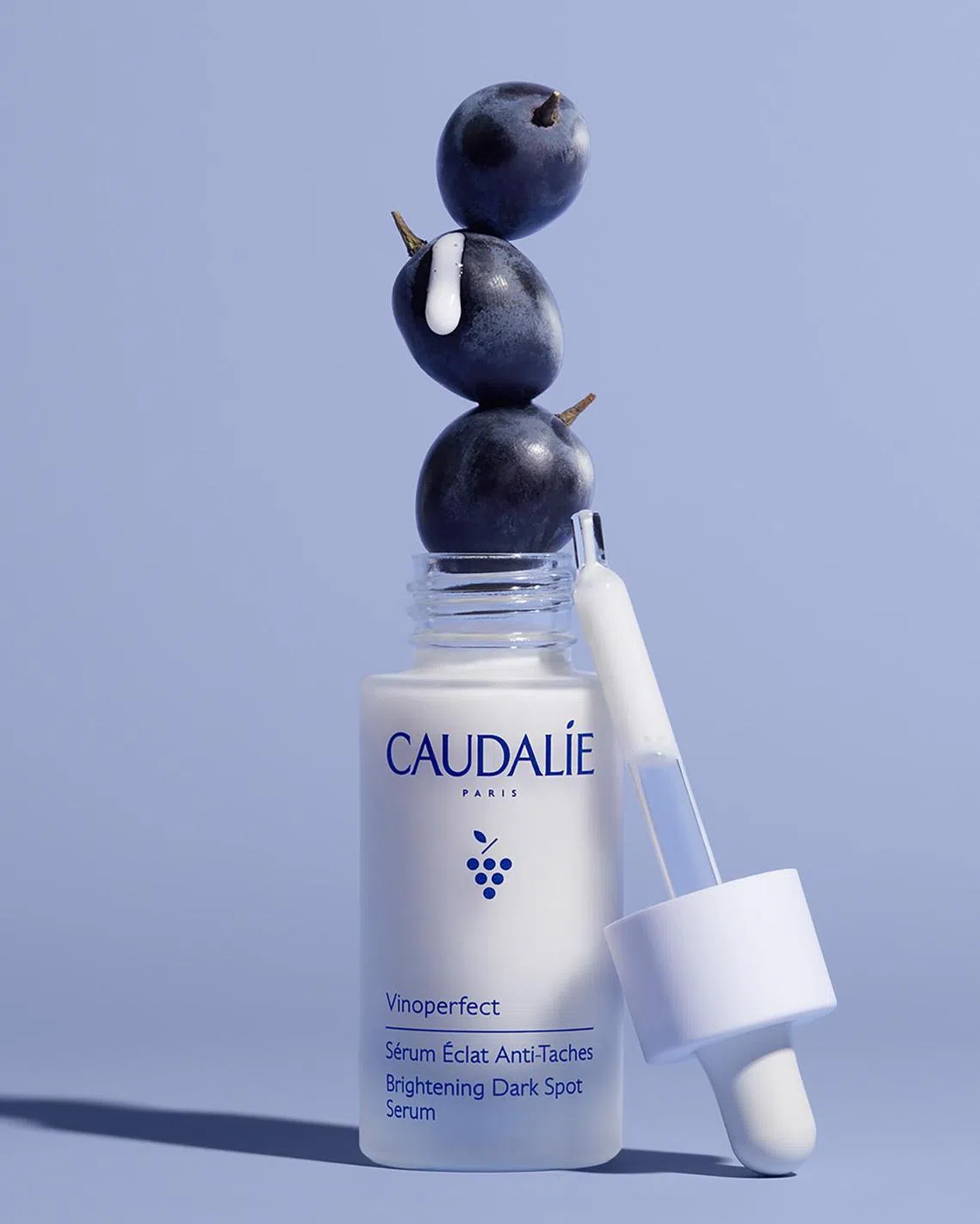Vineyard visionary: French brand Caudalie pioneered clean beauty before it was cool
Sign up now: Get ST's newsletters delivered to your inbox

Mrs Mathilde Thomas at her parents' vineyard, the Chateau Smith Haut Lafitte, where she opened Caudalie's first Vinotherapie Spa in 1999.
PHOTO: CAUDALIE
Follow topic:
SINGAPORE – It was the viral Instant Detox Mask that first made the world sit up and take notice.
This seemingly unassuming face mask from clean skincare brand Caudalie exploded on TikTok in 2021, with users swearing by its ability to banish dull skin and shrink pores after just a few uses.
The hashtag #caudaliedetox has amassed tens of millions of views and continues to grow, propelling Caudalie – once a niche favourite among French beauty aficionados – to global fame.
This was all thanks to a piece of advice Caudalie’s co-founder Mathilde Thomas received from a Sephora executive some years ago: “If you want to be successful, create a TikTok account and give it to your Gen Z daughter.”
Taking this advice to heart, the French entrepreneur handed the social media reins to her teen.
Mrs Thomas, who was in town with her co-founder-husband Bertrand Thomas in September for the relaunch of the brand’s Vinoperfect Brightening Dark Spot Serum, recalled how her daughter posted a video showcasing the Instant Detox Mask’s pore-minimising effects in just 10 minutes.
“The video went viral and, soon after, a Canadian content creator stitched it, turning it into a major sensation.”
However, Caudalie has been perfecting clean skincare long before it became trendy.
The daughter of professional skiers Daniel and Florence Cathiard, Mrs Thomas grew up in Grenoble, a charming village nestled at the base of the French Alps. Since both her parents were deeply committed to their careers, she was raised by her grandparents, who instilled in her a profound appreciation for the medicinal and regenerative powers of plants.
“We had access to dozens of the best beauty regimens right in our own backyard. My grandmother would make a luxurious facial mask from honey in the beehive at the corner of our garden… she’d whip up a super-moisturising and nourishing hair mask from fresh, green, pungent olive oil and rum, and we’d sit together, giggling at the scent, till our hair was saturated,” Mrs Thomas writes in her 2015 book The French Beauty Solution.

Mrs Mathilde Thomas talks about beauty secrets she learnt growing up on a vineyard in Bordeaux in her book, The French Beauty Solution (2015).
PHOTO: CAUDALIE
These early rituals ignited her passion for the beauty industry.
In 1990, Mrs Thomas met her future husband at business school, and the couple, who are now in their 50s and have three children together, conceived the idea for Caudalie.
Their vision was inspired by a pivotal meeting with Professor Joseph Vercauteren, laboratory director at the University of Bordeaux’s pharmaceutical science faculty, who revealed that grape seeds contained some of the most potent antioxidants in the world.
This discovery ignited their desire to create a beauty brand that harnessed the antioxidant power of grapes grown at Chateau Smith Haut Lafitte, a Bordeaux-based winery belonging to Mrs Thomas’ parents.
Mr Thomas recalls: “When we first discussed this project, we had very different but complementary visions. I was focused on the product’s cost, sales and distribution, while Mathilde was dedicated to creating a clean, effective formula and ensuring the brand’s appeal.”
In 1995, Caudalie was born. Its first product, a moisturiser for all ages, leveraged the anti-ageing benefits of grape seed polyphenols and excluded harmful ingredients like parabens and phthalates.
At that time, however, clean beauty was still in its infancy, and the Thomases faced significant challenges in promoting their products.
Mr Thomas says: “When we introduced our grape seed-based products, there was considerable scepticism. Natural beauty was mostly associated with animal-derived collagen back then. The rich would go to La Prairie in Switzerland for sheep placenta injections. People weren’t yet interested in clean beauty, and explaining its benefits was a tough sell.”

Caudalie co-founders Bertrand and Mathilde Thomas were in town recently for the relaunch of their best-selling product, the Vinoperfect Brightening Dark Spot Serum.
PHOTO: CAUDALIE
Undeterred, the two continued to push forward, eventually opening their first vinotherapy spa using wine by-products at Chateau Smith Haut Lafitte in 1999. The Caudalie Spa des Sources offered innovative facial and body treatments featuring natural active ingredients from the grapevine and grapes.
“People from all over the world came, thinking we were soaking in wine barrels,” Mrs Thomas recalls with a chuckle. “That wasn’t what we were doing at all, but the curiosity surrounding it gave us international exposure.”
Clean beauty had also made significant strides over the years, and this shift played a major role in helping Caudalie gain more recognition.
“Clean beauty really took off when social media began pushing the concept, and with the rise of apps like Yuka, which launched in 2017 in Europe,” says Mr Thomas.
“These apps allow users to scan products and instantly see their safety based on the ingredient list. It’s incredibly educational because you can click on individual ingredients to understand what’s good and what’s potentially harmful. This movement empowered consumers to make informed choices.”
However, Caudalie’s true turning point came in the 2000s.
With the help of Prof Vercauteren, the brand achieved a major breakthrough by stabilising resveratrol, a potent polyphenol known for its anti-ageing and firming properties. This allowed Caudalie to become the first skincare company to patent the powerful natural ingredient.
In 2005, Caudalie reached another milestone by patenting viniferine, a compound extracted from the sap of vine stalks. Traditionally used by women working in the vineyards who would rub the sap on their skin, viniferine is said to be 62 times more effective than Vitamin C in fading dark spots and restoring natural radiance.
It has since become the star ingredient in many of Caudalie’s products, most notably the Vinoperfect Brightening Dark Spot Serum, which holds the title of the No. 1 anti-dark spot product in France, with one bottle sold every 30 seconds. Its success has even led to luxury cosmetic brands creating their own dupes.
“Most of these competitors have since disappeared. The challenge for them was they didn’t know how to properly extract the antioxidants from grape seeds or stalks, let alone stabilise them. But their attempts gave us good publicity,” says Mr Thomas.

First launched in 2005, the Vinoperfect Brightening Dark Spot Serum has been the brand’s best-selling product ever since.
PHOTO: CAUDALIE
By 2018, the Thomases took a bold step to reformulate Caudalie’s products to be even cleaner and more sustainable.
Mrs Thomas says: “I told Bertrand, ‘I don’t feel comfortable any more because we’re not leading in clean and natural formulations. We’re still leaders in effectiveness, but I want to take it further. I want all of our formulas to be at least 95 per cent natural.’
“On top of that, we hired packaging engineers to ensure all our packaging was either recycled, recyclable or refillable.”
This commitment led to the exclusion of over 70 ingredients from Caudalie’s products. Some of these, according to Mrs Thomas, were a “nightmare” to eliminate.
“The beauty industry loves these ingredients because they’re cheap, easy to formulate with and incredibly stable,” she says. “But many suppliers of these ingredients don’t even realise there are microplastics in the molecules. We know because we conduct extensive testing.”
But the couple were pleasantly surprised to discover that removing certain ingredients actually enhanced the product’s effectiveness.
“We eliminated all the PEG (polyethylene glycol) ingredients that I no longer wanted to include, and the result was astonishing – the formula became 3.9 times more effective because it penetrated the skin better,” says Mrs Thomas.
Caudalie’s dedication to purity has driven the couple to build a library of over 1,000 ingredients in their French laboratory.
“We source, test and scan every ingredient thoroughly, so we know everything about what goes into our products,” she adds.
The Covid-19 pandemic, though challenging for many industries, proved to be a blessing in disguise as Caudalie’s business has doubled over the past four years.
Says Mr Thomas: “Covid-19 made people more conscious of taking care of themselves, whether it’s what we eat, what we apply to our skin or even how our choices impact the planet.”
Today, Caudalie is available in 52 countries across Asia, Europe, North America, South America and Oceania, with 35 standalone boutiques and spas, and four more in five-star hotels and palaces.
The brand can also be found in more than 16,000 pharmacies and over 2,000 selective stores and department stores.
It boasts over 100 products and is gearing up to launch a new series focused on longevity in January 2025. This collection is the result of a collaboration with Dr David Sinclair, a leading genetics professor at Harvard Medical School.
“Working with Dr Sinclair has been enlightening,” says Mr Thomas. “They’re studying how to reverse ageing and extend the health span – the idea that it’s not about living longer, but about living healthier as you age. The goal isn’t to make you live to 100, but to ensure that if you live to 90, you’re still walking and enjoying life from 80 to 90.”
As Caudalie continues to grow, the Thomases remain fiercely committed to their independence, a rarity in an industry where most beauty brands are absorbed by large corporations.
Despite numerous offers from big players, selling has never crossed their minds.
“About 99 per cent of beauty brands are owned by huge corporations with endless resources. But we’ve seen first-hand that when disruptive, entrepreneurial brands are sold, they lose their soul and their identity. They become bland and lose the innovative edge that made them special,” says Mr Thomas.
For them, Caudalie is more than just a business.
“We’re proud of everything it stands for and how far we’ve come. The more we grow, the more connected we feel with the brand and the more energised we feel,” he adds.

